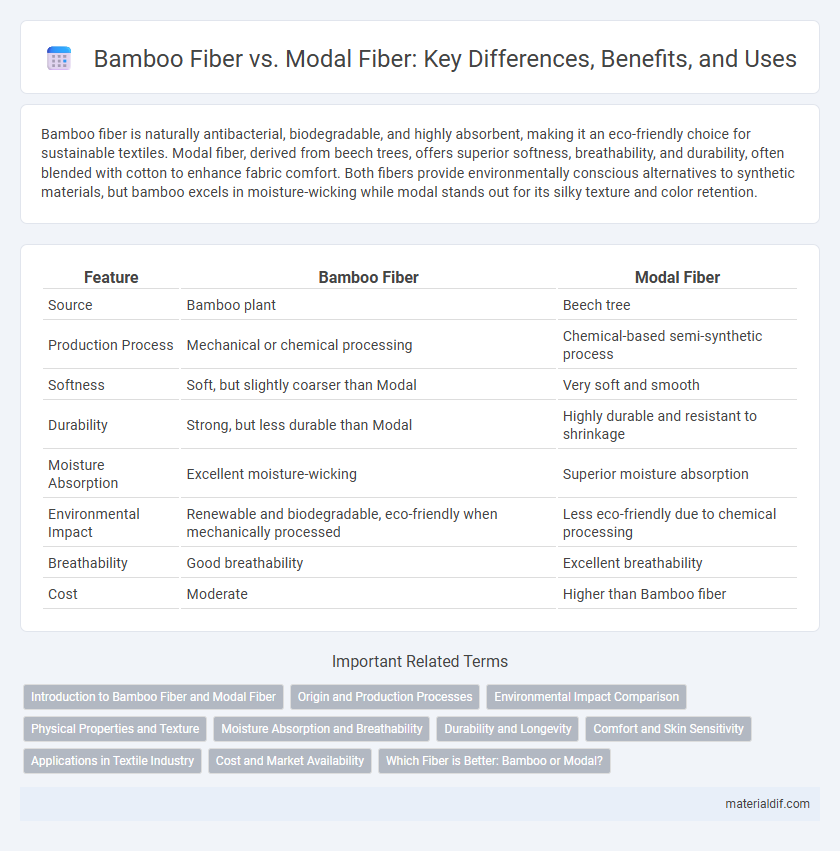Bamboo fiber is naturally antibacterial, biodegradable, and highly absorbent, making it an eco-friendly choice for sustainable textiles. Modal fiber, derived from beech trees, offers superior softness, breathability, and durability, often blended with cotton to enhance fabric comfort. Both fibers provide environmentally conscious alternatives to synthetic materials, but bamboo excels in moisture-wicking while modal stands out for its silky texture and color retention.
Table of Comparison
| Feature | Bamboo Fiber | Modal Fiber |
|---|---|---|
| Source | Bamboo plant | Beech tree |
| Production Process | Mechanical or chemical processing | Chemical-based semi-synthetic process |
| Softness | Soft, but slightly coarser than Modal | Very soft and smooth |
| Durability | Strong, but less durable than Modal | Highly durable and resistant to shrinkage |
| Moisture Absorption | Excellent moisture-wicking | Superior moisture absorption |
| Environmental Impact | Renewable and biodegradable, eco-friendly when mechanically processed | Less eco-friendly due to chemical processing |
| Breathability | Good breathability | Excellent breathability |
| Cost | Moderate | Higher than Bamboo fiber |
Introduction to Bamboo Fiber and Modal Fiber
Bamboo fiber is a natural textile made from the pulp of bamboo grass, renowned for its breathability, moisture-wicking properties, and eco-friendly cultivation process. Modal fiber, a type of semi-synthetic rayon derived from beech tree cellulose, offers exceptional softness, durability, and resistance to shrinkage. Both fibers are popular in sustainable fashion, with bamboo fiber emphasizing natural antibacterial qualities and modal fiber prized for its smooth texture and color retention.
Origin and Production Processes
Bamboo fiber is derived from the cellulose of bamboo plants through mechanical crushing or chemical processing, often involving environmentally intensive steps like bleaching. Modal fiber, a type of semi-synthetic cellulose fiber, originates from beech tree pulp and is produced using a more controlled and eco-friendly process known as the viscose method, which enhances fiber strength and softness. Both fibers serve as sustainable alternatives to cotton, but modal's production offers greater consistency and reduced environmental impact compared to the more variable bamboo textile manufacturing techniques.
Environmental Impact Comparison
Bamboo fiber boasts a lower environmental footprint due to its rapid growth rate and minimal pesticide use, making it a highly sustainable resource compared to Modal fiber, which is derived from beech trees requiring intensive water and chemical treatment during production. The manufacturing process of Modal fiber involves significant energy consumption and chemical solvents that can impact ecosystems if not properly managed, whereas bamboo fiber's processing is generally more eco-friendly but may involve chemical treatment to enhance softness. Overall, bamboo fiber presents a more renewable and biodegradable option, but responsible sourcing and processing remain critical to minimizing environmental harm in both fibers.
Physical Properties and Texture
Bamboo fiber exhibits superior moisture-wicking properties and natural antibacterial qualities, making it highly breathable and hypoallergenic, while Modal fiber is known for its exceptional softness, smooth texture, and excellent drape. Bamboo fiber maintains strength even when wet and feels slightly more textured, whereas Modal fiber offers a silky, lightweight finish that resists shrinking and fading. Both fibers provide comfort, but bamboo enhances durability and eco-friendliness, contrasting with Modal's luxurious softness and sheen.
Moisture Absorption and Breathability
Bamboo fiber exhibits superior moisture absorption with a capacity of up to 3.5 times its weight in water, promoting excellent breathability and quick-dry properties compared to Modal fiber, which absorbs less moisture but offers a softer texture. The natural micro-gaps in bamboo fiber enhance ventilation, making it more breathable and suitable for activewear and warm climates. Modal fiber, derived from beech trees, provides moderate breathability but may retain more moisture under high humidity conditions.
Durability and Longevity
Bamboo fiber offers natural antibacterial properties and high tensile strength, contributing to its excellent durability and resistance to wear over time. Modal fiber, derived from beech trees, is known for its smooth texture and superior color retention but tends to be less resilient under repeated stress compared to bamboo. Both fibers enhance fabric longevity, yet bamboo fiber's robustness makes it a preferred choice for long-lasting sustainable textiles.
Comfort and Skin Sensitivity
Bamboo fiber offers exceptional breathability and moisture-wicking properties, making it ideal for sensitive skin by reducing irritation and promoting a cool, dry feel. Modal fiber, derived from beech trees, provides a soft, silky texture with high absorbency, enhancing comfort for those with delicate skin types. Both fibers excel in softness and skin compatibility, but bamboo fiber is often preferred for its natural antibacterial qualities and superior moisture management.
Applications in Textile Industry
Bamboo fiber offers excellent moisture-wicking and antibacterial properties, making it ideal for activewear, underwear, and eco-friendly textiles in the fashion industry. Modal fiber is prized for its softness, durability, and resistance to shrinkage, commonly used in luxury apparel, bedding, and loungewear. Both fibers contribute to sustainable textile production, with bamboo promoting biodegradability and modal supporting enhanced fabric strength.
Cost and Market Availability
Bamboo fiber offers a cost-effective alternative with increasing market availability, driven by its eco-friendly appeal and sustainable production methods. Modal fiber, often priced higher due to its refined processing from beech trees, maintains strong market presence in premium textile segments. Both fibers show growing demand, but bamboo's affordability and expanding supply channels make it a competitive choice for budget-conscious manufacturers.
Which Fiber is Better: Bamboo or Modal?
Bamboo fiber offers superior sustainability due to its rapid growth and minimal water usage, making it an eco-friendly textile option. Modal fiber, derived from beech trees, provides exceptional softness and durability with enhanced moisture-wicking properties ideal for activewear. Choosing between bamboo and modal fibers depends on prioritizing environmental impact versus fabric performance and comfort.
Bamboo fiber vs Modal fiber Infographic

 materialdif.com
materialdif.com